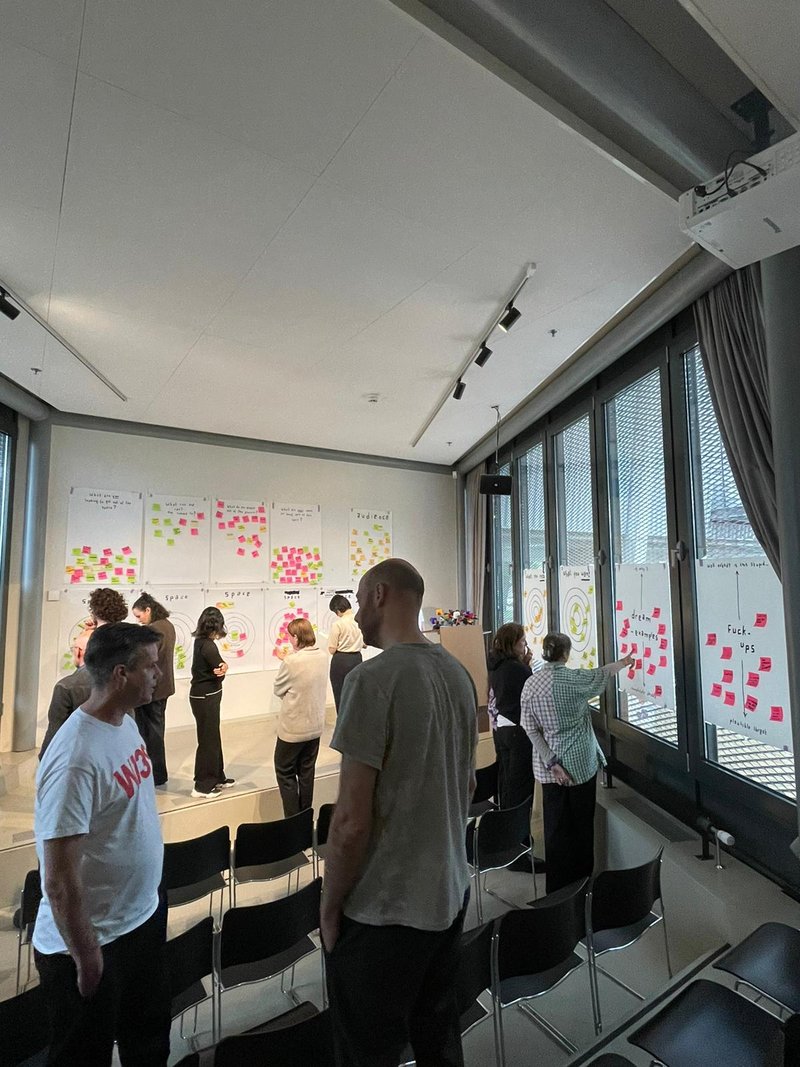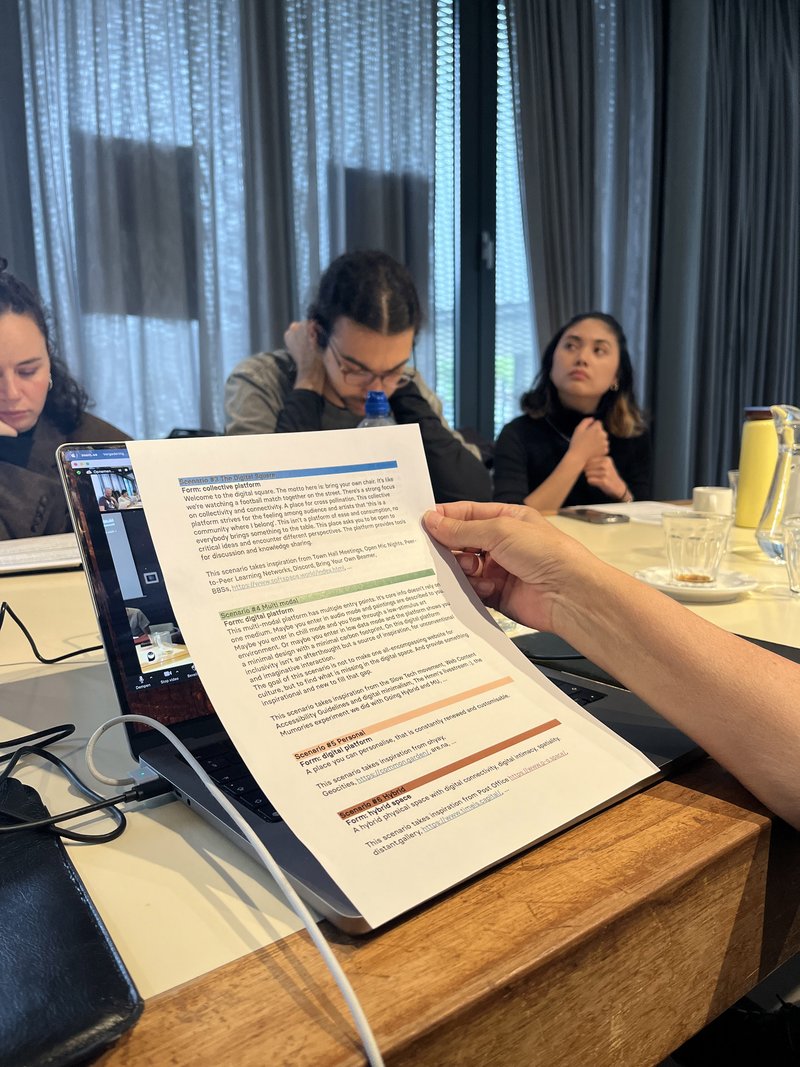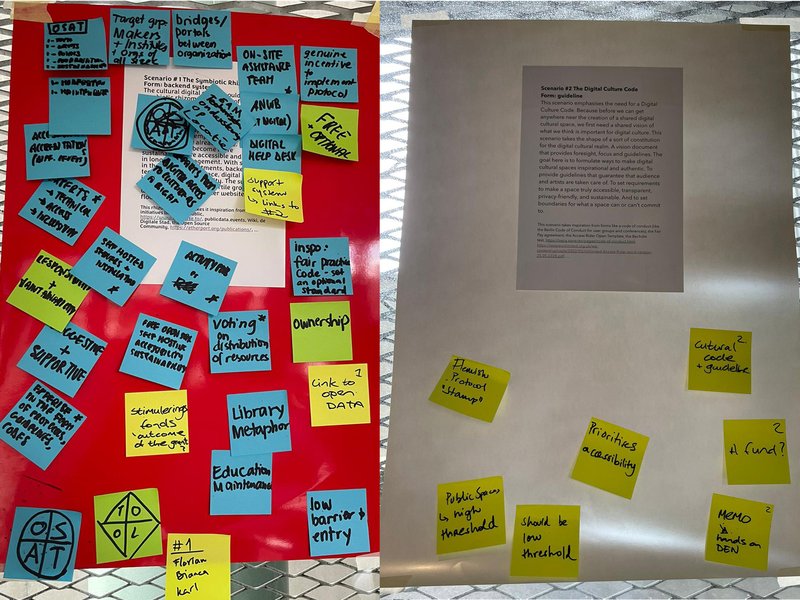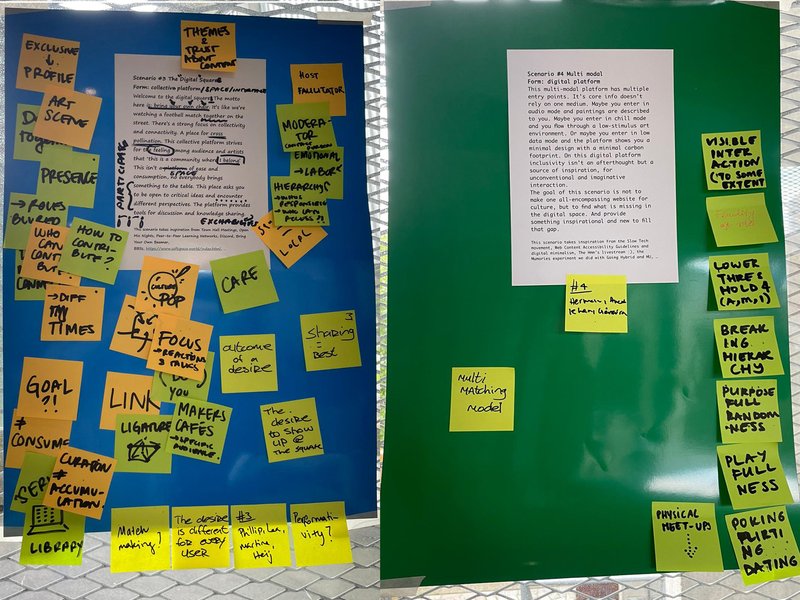report
7 scenarios
Part 1 - Introduction & General Themes
All participants have previously attended at least one session. They return because they view it as a unique opportunity for independent makers to have a say and contribute. They appreciate the various brainstorming methods, such as using maps and metaphors. Participants believe it is important to collaboratively determine the future of a platform dedicated to makers. They are curious and excited about designing a platform for makers and gaining insights from different types of makers. Anania mentioned feeling like an outsider trapped in a bubble, and this opportunity helps her feel involved in something significant with other makers. Participants want to hear others’ perspectives and see this as a learning experience. However, they also questioned the project’s scale, finding it challenging to challengebuild a single platform. Reflecting on the last sessions, they noted there are still some loose ends and are looking forward to desiremaking the project more concrete.
Past sessions

Participants discuss and remember the previous maps
In the first two listening sessions, participants shared valuable insights and concerns. These sessions were primarily about listening, gathering values, and intentions. Today marks a shift from listening to action. DEN’s task is to gather opinions to design a suitable space, even if it might not exist. The group will now review various maps created during previous sessions, covering needs, desires, fears, commonalities, and accessibility requirements. Key desires include desirespaces to showcase work, authenticity, maker agency, and open-source principles. Key fears revolve around concernpolitical agendas, standardization, low quality, competitiveness, and algorithmic governance. Moving forward, the group aims to build upon six scenarios to create a proposal for DEN, acting as a bridge between ideas and practical implementation. They’ll assess the extent to which participants agree with the scenarios and explore potential combinations. These scenarios serve as foundational building blocks for the next phase, helping to refine the platform’s aim and structure.
General themes
Participants expressed a weariness of looking too much into the past and a desire to desiremove away from the era of independent but interconnected HTML websites. They found it challenging to challengeunderstand and envision an innovative future while recognizing a interesting-practicegrowing longing for physical spaces, especially among young people. The general theme revolved around revival and the cyclical nature of development, akin to AI generation, which builds only on past data. They mentioned potential fears in every new solution, arguing that they might be concerninvasive. This tendency often leads us back to default modes of thinking, neglecting those excluded from such designs, a habit reinforced by the influence of traditional media.
Part 2 - Scenarios & the Audience of the Future

List of all scenarios prepared
Rogier, Angelique, and Lilian presented scenarios representing diverse forms of digital platforms. Participants shared their opinions on these scenarios, discussing ways to improve and combine them for better functionality and inclusivity. Genevra marked her confusion because the scenarios seem to have different goals and audiences despite the connections between many scenarios, questioning whether reflectionmatchmaking is a desired feature. She pointed out a blindspot: the navigation and desire to navigate the platform vary depending on the user. She proposed considering a multi-matching model.


Scenarios as presented to the group and chosen by participants to further develop, with collective annotations
Black scenario
Form: basic website
This scenario illustrates a typical, conventional website, representing the standard digital platform we commonly envision. It lacks innovation and inclusivity, serving as a reference point for what creators should avoid.
Scenario # 1 The symbiotic rhizome
**Form: backend system **
The cultural digital space should be a symbiotic rhizome consisting of smaller independent websites. The priority is not to build a new all-encompassing website for all, but to create a support system for this network of already existing initiatives. This support system strengthens and empowers the cultural websites that are already there. It enables them to become more sustainable, more accessible and invest in long-term engagement. With support in the form of investments, backend technology, server space, digital tools, inter-linking and publicity. The support system functions like a fertile ground in which all kinds of smaller websites can flourish.
This rhizome scenario takes it inspiration from initiatives like WeArePublic, the Fediverse, publicdata.events, Wiki, de Digitale Stad, and the Open Source Community, https://etherport.org/publications/, https://www.fediverse.to/.
Participants’ opinion:
When discussing this scenario, participants discussed that it might involve an reflectionunderlying system customizable by each institution, focusing more on concernproviding a service than fostering a community, which they believe is crucial. They also feared that a rigid code of conduct, tied to specific cultures, could lead to concernstatic rules that do not adapt well to diverse cultural contexts.
Participants’ proposition:
Bianca, Karl, and Florian envision a solutionfoundation where various scenarios can converge and contribute, creating a robust support system for makers. This foundation would serve as a bedrock for other initiatives, fostering a collaborative environment. The implementation of this foundation would involve a desirecoalition of cultural organizations, tech companies committed to ethical practices, and government bodies. To ensure the foundation is free and intentional, substantial funding from grants, public funds, and private donations would be required. solutionPartnerships with educational institutions and tech companies could also provide resources and expertise. A key feature of this foundation would be an desireon-site assistance team, a dedicated desk offering personalized help to makers, guiding them in transforming their ideas into tangible products or services. This team would provide accessibilityethical, free expertise, including suggestions and proposals around accessibility, self-hosting, and open-source software. Establishing clear protocols on accessibility would be essential, accessibilityensuring that all digital products and services are accessible to everyone. Inspired by the Belgian system, where interesting-practiceorganizations in Flanders can earn a special stamp if they meet specific criteria such as inclusivity (as Karl noted) and receive assistance in digitizing makers’ collections (as Hay added), users could subscribe to these protocols to receive both guidance and potential funding. Rather than centralizing everything on one platform, solutionthe foundation would operate through a network of fragmented yet interconnected services. This approach resembles a library or social service for digital culture, offering practical support to organizations at no cost. Starting from a more theoretical standpoint, quotethe foundation highlights the current lack of assistance for makers and proposes a more ethical and free support system.
Scenario #2 The Digital Culture Code
Form: guideline
This scenario emphasises the need for a Digital Culture Code. Because before we can get anywhere near the creation of a shared digital cultural space, we first need a shared vision of what we think is important for digital culture. This scenario takes the shape of a sort of constitution for the digital cultural realm. A vision document that provides foresight, focus and guidelines. The goal here is to formulate ways to make digital cultural spaces inspirational and authentic. To provide guidelines that guarantee that audience and artists are taken care of. To set requirements to make a space truly accessible, transparent, privacy-friendly, and sustainable. And to set boundaries for what a space can or can’t commit to.
This scenario takes inspiration from forms like a code of conduct (like the Berlin Code of Conduct for user groups and conferences), the Fair Pay agreement, the Access Rider Open Template and the Bechdel test., https://varia.zone/en/pages/code-of-conduct.html,
https://weareunlimited.org.uk/wp-content/uploads/2022/05/Unlimited-Access-Rider-word-version-25.05.2228.pdf
Participants’ opinion:
Hay highlighted how reflectionlicenses and rules closely align with cultural codes, emphasizing the importance of understanding diverse cultural contexts. Karl proposed an intriguing alternative, suggesting a solutionfund where makers receive guidelines and trust to independently address questions, diverging from the current technology-centric approach. Lea raised concerns in this scenario regarding concernownership and the potential for individuals to become mere contributors to large entities, with machines doing the bulk of the work, prompting a deeper exploration into collaborative ownership models.
Scenario #3 The Digital Square
Form: collective platform
Welcome to the digital square. The motto here is: bring your own chair. It’s like we’re watching a football match together on the street. There’s a strong focus on collectivity and connectivity. A place for cross pollination. This collective platform strives for the feeling among audience and artists that ‘this is a community where I belong’. This isn’t a platform of ease and consumption, no everybody brings something to the table. This place asks you to be open to critical ideas and encounter different perspectives. The platform provides tools for discussion and knowledge sharing.
This scenario takes inspiration from Town Hall Meetings, Open Mic Nights, Peer-to-Peer Learning Networks, Discord, Bring Your Own Beamer, BBSs, https://www.softspace.world/index.html.
Participants’ opinion:
Bianca reflected this scenario, noting the shift from sustainable online communities to a dynamic where participants morph into audience and provider roles, with facilitators being active and readers passive. She found the concept of the opiniondigital square particularly relevant, highlighting the time investment required for participation and the challenge of maintaining equal positions within the community. Martijn pointed out the underlying problem of scenarios attempting to offer a concern"one size fits all" solution, stressing the diverse needs and scales of cultural spaces. However, he acknowledged the risk that without such universal solutions, the least demanding option might prevail. Besides, Lea expressed a preference for this scenario, emphasizing the shared experiences it fosters. Karl disagreed with this preference, suggesting opinionalternative perspectives might be needed to fully consider the square's potential. Moreover, Sondi pointed out that some communities might already engage in similar practices but require additional funding to sustain them. Filipp reiterated support for the digital square, emphasizing its potential as a opinionliberal and non-anarchic platform for interaction and self-presentation. He would choose to implement a selection process to actively promote diversity.
Participants’ proposition:
Martina, Hay, Lea, and Filipp conceptualize a scenario where events take place weekly or monthly in various locations, such as cafes, providing solutionspaces for discussion and a means to discover new speakers for events. This format could eventually evolve into a more extensive infrastructure. The scenario emphasizes hybridity, aiming to desirecreate holistic connections between physical and digital spaces, which would help sustain the format. solutionEvents would be archived and tagged to facilitate finding people with similar mindsets and goals.To ensure accessibility and inclusivity, each month could feature a inclusiondifferent theme, targeting diverse audiences and prioritizing connections over backgrounds. The concept would be standardized to maintain a consistent atmosphere across different times and locations, requiring hosts, moderators, and facilitators to manage the events. Rather than being owned by a single organization, this format focuses on groups of people coming together. The hierarchy within this scenario would be centered around the role of the moderator, with organizations responsible for the moderators representing them in these events. This model could be compared to the Tegenlicht meetups, which also emphasize connections and successful elements from existing formats. The scenario supports a solutionmultimodal approach, catering to various visions, publics, and audiences, and desireblurring the lines between audience and contributor. To elaborate on the shared reality of digital and physical spaces, a starter pack could be provided to help set up the initial events, allowing for growth through a connected web or network. quoteThis would address the challenge makers face when organizing events, particularly the difficulty in finding infrastructure.
Scenario #4 Multi modal
Form: digital platform
This multi-modal platform has multiple entry points. It’s core info doesn’t rely on one medium. Maybe you enter in audio mode and paintings are described to you. Maybe you enter in chill mode and you flow through a low-stimulus art environment. Or maybe you enter in low data mode and the platform shows you a minimal design with a minimal carbon footprint. On this digital platform inclusivity isn’t an afterthought but a source of inspiration, for unconventional and imaginative interaction.
The goal of this scenario is not to make one all-encompassing website for culture, but to find what is missing in the digital space. And provide something inspirational and new to fill that gap.
This scenario takes inspiration from the Slow Tech movement, Web Content Accessibility Guidelines and digital minimalism, The Hmm’s livestream :), the Mumories experiment we did with Going Hybrid and MU
Participants’ proposition:
The scenario explores how artists can desiremeet and crossover in new online forms. Hermen, Genevra, Anania, and Kaan suggest that different ways to navigate the platform would cater to various modalities of institutions, makers, and visitors, utilizing combinations of text and images. solutionVisitors could publicly suggest matches between institutions and artists in a non-formal, barrier-free environment where everyone can playfully initiate interactions without fixed positions. Events would be organized by inclusionthemes and strengths, encouraging crossovers of different mediums. opinionThere is a noted lack of surprise in navigating digital platforms, prompting consideration of the opportunities presented by “mistakes.” This element of purposeful randomness could be interesting-practiceinspired by the dating app format, introducing serendipitous encounters similar to the “I’m feeling lucky” button. To maintain a dynamic and engaging experience, moderators in this scenario would function like cupids, facilitating matches and interactions. Lea highlighted that this system would push people to solutiontake action and assume responsibility seamlessly, akin to a poke system that requires no commitment. The challenge remains to challengeensure a diverse audience participates. quoteThis approach could reinvigorate organizations that might be experiencing boredom with traditional methods, offering a hierarchy-flattening experience and encouraging spontaneous, playful connections.
Scenario #5 Personal
Form: digital platform
A place you can personalise, that is constantly renewed and customisable.
This scenario takes inspiration from ohyay, Geocities, https://common.garden/, are.na.
Participants’ opinion:
This scenario appears to be the opinionleast popular among the group. Martijn draws parallels with a project by Richard Vijgen where Geocities was downloaded and made accessible once again.
Scenario #6 Hybrid
Form: hybrid space
A hybrid physical space with digital connectivity, digital intimacy, spatiality.
This scenario takes inspiration from Post Office https://www.p-o.space/, distant.gallery, https://www.timeis.capital/.
Participants’ opinion:
Martijn suggests that opinionhybridity would offer valuable methodologies for younger generations, making the scenario potentially more appealing and insightful to them.
Participants’ proposition:
Nadia, Sondi, and Martijn explore the boundaries of online meeting spaces, considering how to connect people across different geographies and link cultural and non-cultural spaces to initiatives and ideas. They aim to facilitate digital connections that go beyond local bubbles, addressing the need to desirereach wider audiencesrather than just friends of friends. This scenario envisions solutionindexing spaces available for makers, allowing them to step outside their familiar circles and discover new cultural hubs. To achieve this, they propose an indexing platform where people can easily find cultural resources and spaces, thus desiresharing dormant resources with minimal effort. This approach can accessibilityhelp institutions reach new audiences by connecting with small initiatives through digital means. Florian suggested that such a platform could serve as an interesting case study, given the disappearance of small grassroots initiatives in Dutch culture over the past 20 years. Meanwhile, Lilian emphasized the importance of questioning reflectionwhether these connections should remain purely digital or adopt a hybrid model. Additionally, Martijn noted that this scenario challenges organizations to challengereconsider their role within the cultural scene. Hay further highlighted the value of DIY efforts and the necessity ofdesireallowing space for trial and error, as the current emphasis on professionalism leaves little room for experimentation and failure. Building on this, Florian pointed out the challengedifficulty unknown makers face in finding venues to showcase their work due to the many layers within the cultural sector. In response, Angelique added that challengeinstitutions also struggle to present unknown makers. Finally, Sondi stressed the desireneed for connections that benefit not just the well-known makers but also those who are emerging or lesser-known. quoteThis scenario offers a simple methodology for opening up cultural spaces and connecting diverse initiatives through digital means, helping both institutions and makers broaden their reach and impact within the cultural landscape.
Part 3 - Wrap-up and Looking Forward
Lilian emphasizes that as digital makers, they are inclined to experiment with various tools and technologies, having grown up as digital natives. quoteThey represent the "innovators" percentage, contrasting with DEN's majority perspective. TNO, in collaboration with DEN, has conducted previous research on digital transformation, interviewing institutions (such as MU) to highlight motivations such as inclusivity, diversity, and the facilitation of new cultural experiences. One participant raises a valid concern regarding the research potentially reflecting a concerndated mentality, akin to a mindset prevalent in the 90s. They draw attention to the reflectionassociation of technology in the cultural sector with the stereotype of the "IT guys", highlighting the need to address this issue with DEN. This association not only perpetuates gatekeeper culture but also underscores the inclusionimportance of challenging outdated perceptions and promoting inclusivity in digital spaces.
Another participant underscores the crucial role of intentionality in digital transformations, warning against concernblindly following the trajectory of "big tech" without desiredeliberating on factors such as access, reach, and services. They proposed exploring alternatives like Nextcloud over platforms like Google Drive, citing ethical considerations, although they acknowledged the challenges associated with such transitions. Furthermore, participants questioned DEN’s concentration on a singular, expansive digital space, advocating instead for a more desireholistic and diversified cultural landscape that extends beyond the constraints of platforms like TikTok.
Florian highlights the importance of desireamplifying the voices and desires of young people within institutions, echoing a sentiment shared by the group. Additionally, there was a suggestion to interesting-practiceutilize existing databases within the cultural sector to extract valuable insights. Hay stresses that the interesting-practicequest for new digital audiences often originates in physical spaces and suggests exploring innovative digital transformations, such as cafes with restricted phone and internet access, as a means of fostering genuine human connections. The group also discussed the multi-faceted nature of digital transformation, acknowledging its complexity and potential for varied approaches and outcomes.
For the final meeting
The group proposes mixed working groups comprising both makers and DEN members to redefine the problem statement and approach digital spaces collaboratively. They assign homework for DEN to read the written scenarios in preparation for the next session, along with collecting questions from the group.
The makers have expressed their desire to begin the next session with an introduction on how they perceive digital transformation. They intend to showcase the scenarios and framework for each, while ensuring that the discussion remains somewhat abstract. Their aim is to influence through language, emphasizing that digital transformation is not solely about adopting new technologies, but rather about embracing a new value system. This approach underscores their commitment to shaping the discourse around digital transformation in a way that prioritizes values and principles over concrete technological solutions.